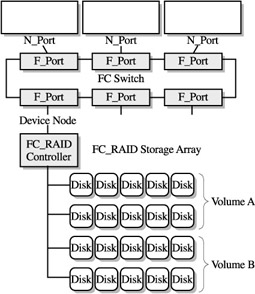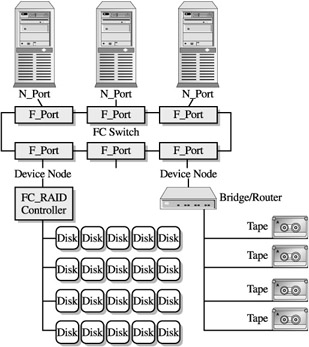Putting the Storage in Storage Area Networks
| |
Given that SANs are Storage Area Networks, perhaps the single most exigent component in the configuration is the storage itself. SANs require storage that is Fibre Channel- enabled. In other words, FC disks must be connected to the switch via an FC topology. Fibre Channel-enabled disks come in two configurations: JBOD, Just a Bunch Of Disks, and RAID, Redundant Array of Independent Disks. Each configuration maintains its own set of FC features and implementations .
FC storage arrays, which are multiple disks hooked together, are connected in a loop configuration, as depicted in Figure 14-6. Loop configuration allows each disk to be addressed as its own unique entity inside the segment. FC storage arrays (depicted in Figure 14-6 as well) also provide additional functions, such as the stripping of data across the units, which allows a single outsized file to be spread across two, three, or even four drives in the array. In addition, most provide low-level enclosure management software that monitors the device's physical attributes (its temperature, voltage, fan operation, and so on).

Figure 14-6: An FC storage array connected in a loop configuration
JBOD
A typical JBOD configuration is connected to the switch through an NL port. Most implementations provide dual loop capacity whereby redundancy protects against single loop failure. In other words, should one loop go down, the information on the storage device can be retrieved via the second loop. A dual loop requires four of the switch's ports. Another, less typical method of attaching a JBOD array to a switch is to split the devices into separate loops. A JBOD array of eight drives could have one loop serving drives 1-4 and a second loop for drives 5-8. This method also requires four ports on the switch. The benefits of splitting the devices into several loops include shorter path lengths and less arbitration overhead within the loop itself.
The disadvantage of any JBOD implementation is its lack of fault resiliency, though there are software RAID products that allow the stripping of data with recovery mechanisms encompassed in the JBOD enclosure. Given the number of disks and the transmission of SCSI commands to multiple targets, using RAID software in conjunction with a JBOD implementation presents its own problems. It is important to keep in mind that while these are Fibre Channel-enabled disks, the disk drives themselves execute a SCSI command set when performing read/ writes .
RAID
A Fibre Channel-enabled RAID storage array places a controller in front of the disk array that provides and controls the RAID level for the disk array (RAID 1-5). RAID offers a way of protecting the data by creating an array of disk drives that are viewed as one logical volume. Inside this logical volume, which may consist of seven drives, data is partitioned, as is recovery information. In the event of a single drive failure, the array reassembles the information on the remaining drives and continues to run. The RAID controller uses either an N_Port or a NL_Port depending on how the vendor put the disk enclosure together.
Because the RAID controller stands in front of the array, the FC-enabled disks, regardless of their configuration, become transparent. The switch only sees one device, not several linked together. A single RAID controller can also control several arrays, as indicated in Figure 14-7. For example, four volumes , each volume containing seven disks, would equal a RAID system of 28 disks. Still, the switch only sees the RAID controller-just one device. In this scenario, more often than not, the RAID controller will utilize an N_Port, not a loop.

Figure 14-7: An FC RAID storage configuration
The key advantage of Fibre Channel RAID is its ability to provide levels of fault resistance for hardware failures, a feature not found in JBOD configurations. For enterprise-level workloads, this feature is all but mandatory.
Just as the HBA is the critical point between a server's operating system and the switch's operating system, RAID controllers require a level of specific Fibre Channel software that must be compatible with the switch and the HBA. As noted previously, it is the HBA's job to inform the server which disks are available. In a JBOD configuration, this is pretty straightforward. Each disk is an addressable unit. In a RAID configuration, it becomes the controller's duty to specify which disk is addressable. The RAID controller, via the software contained within it, has to identify itself to the switch, specifically the Name Server within the switch, as well as the HBA, in order for the server to know which disks it has access to on the network. This can quickly become confusing, given that RAID deals in logical units, not independent addressable disks.
One last word about Fibre Channel storage, and this goes for RAID and JBOD configurations: when assigning multiple servers to the switch (via the HBA), the servers have to be told which storage resources they are allowed to play with. And this can quickly become tedious. For example, each server has its own file system, and that file system must reflect the location of the files the server has access to. Problems arise when two or more servers have access to the same files. What happens when two servers reach out for the same file? You guessed it trouble, headaches , and a whole lot of shouting. File sharing between servers attached to a Storage Area Network remains a tedious and problematic issue. Consequently, zoning and masking each server's authorized resources continues to be a prerequisite for effective operation. Before you start shouting, and reach for the aspirin, have a look at Chapter 22.
Bridges and Routers
In addition to the challenges posed by file sharing, data sharing, and device sharing, there are standard data center practices that are required for any type of storage model. Every data center must protect the data stored within the arrays. Most accomplish this using backup/recovery software and practices, which entails the use of tape devices as the primary media for archival copy and data copy functions. In a SAN environment, however, this is easier said than done. Fibre Channel-enabled tape devices have been problematic in their support of this new storage model.
To overcome this hurdle , a new type of device was required to bridge the FC protocol into a SCSI bus architecture used in tape media. Because of tape technologies' sequential nature and the resulting complexity entailed with error recovery, tape media has been difficult to integrate. Solving these difficulties required a device that not only bridged the Fibre Channel into the tape controller/drive bus system, but also further required the management of the logical unit numbers (LUNs) that were utilized in the tape's SCSI configuration. The solution was found in bridges, or routers, for Fibre Channel. This is illustrated in Figure 14-8.

Figure 14-8: A simple bridge/router configuration
Although they are compatible with other SCSI devices, routers are primarily known for their capability to facilitate the operation of tape media within a SAN. Routers provide an effective means of establishing a tape media library for SAN configurations. The alternative would be to copy data from the FC storage arrays onto the LAN and shoot it off to a backup server with a directly attached SCSI tape drive. Considering the overhead required, routers provide a much sleeker configuration for data protection. As always though, even the sleek solutions have their drawbacks. Fibre Channel to SCSI routers bring their own performance issues in matching the switch's port performance with the SCSI bus attachment at the other end of the bridge. Due to SCSI transfer rates, speeds across the router will be constantly slower and throughput will be compromised.
When integrating a router solution, it is important to understand what is needed, whether it's a discrete component or one of the integrated solutions that are increasingly creeping into tape subsystem products. In looking at either of these solutions, you'll have to distinguish other protocols besides SCSI that may be necessary to bridge into your SAN configuration. Router technology is beginning to move toward a gateway type solution where Fibre Channel integrates additional I/O and network protocols.
An additional word of caution: routers add yet another level of microkernel operating environment that must be compatible with all of the components across the Storage Area Network. Routers must also be compatible with a significant number of tape systems, which only adds to the complexity of implementation. The surest bet is to approach the integrated solution supported by the tape manufacturer.
| |
EAN: 2147483647
Pages: 192